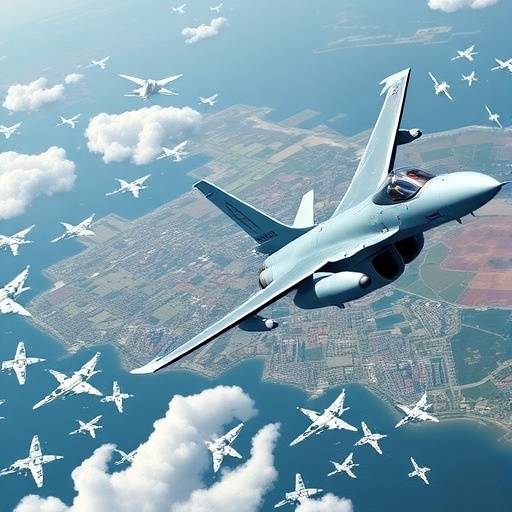France Escalates Ukraine Support with Aster Missiles and Mirage 2000 Jets Amid Intensifying Russian Attacks
In a decisive move that could reshape the skies over Eastern Europe, French President Emmanuel Macron has announced the delivery of advanced Aster missiles and Mirage 2000 fighter jets to Ukraine, bolstering the nation’s defenses as Russian forces intensify their assaults on Kyiv and surrounding regions. This announcement, made during a high-level summit in Paris, underscores France‘s unwavering commitment to Ukraine’s sovereignty amid the ongoing conflict that has ravaged the country since February 2022.
- Macron’s Announcement: A Strategic Pivot in Western Military Aid
- Breaking Down the Arsenal: Power of Aster Missiles in Ukraine’s Defense
- Mirage 2000 Jets: Revitalizing Ukraine’s Aerial Capabilities
- Rising Tensions: Russia’s Response and Ukraine’s Battlefield Realities
- Looking Ahead: Implications for NATO Unity and Conflict Resolution
The aid package, valued at over €3 billion, includes 50 Aster 30 surface-to-air missiles designed for long-range interception and 24 Mirage 2000-5 multirole fighter jets, marking the first time a NATO member has committed to providing such sophisticated aircraft to Ukraine. Macron emphasized the urgency of the shipment, stating, “We cannot stand idly by while Ukraine’s skies are under constant threat. This support is not just military—it’s a stand for freedom and international law.” As Russian drone and missile strikes continue to pound Ukrainian infrastructure, this influx of military aid from France arrives at a critical juncture, potentially tipping the balance in Ukraine’s favor.
Macron’s Announcement: A Strategic Pivot in Western Military Aid
President Macron’s revelation came during a joint press conference with Ukrainian President Volodymyr Zelenskyy, who was visiting Paris to rally further European support. The French leader detailed how the decision was reached after months of consultations with NATO allies, highlighting the escalating nature of Russian aggression. In the past week alone, Russian forces have launched over 150 missile and drone attacks on Ukrainian cities, according to the Ukrainian Ministry of Defense, causing widespread blackouts and civilian casualties.
This isn’t France’s first foray into aiding Ukraine; since the invasion began, Paris has provided more than €2.5 billion in military assistance, including Caesar howitzers and Milan anti-tank missiles. However, the inclusion of Mirage jets represents a significant escalation. “These jets will enable Ukraine to reclaim air superiority in key battle zones,” Macron asserted, pointing to the aircraft’s proven track record in French operations in Mali and Libya.
Behind the scenes, French defense officials revealed that training programs for Ukrainian pilots on the Mirage 2000s will commence immediately at a secure base in Romania, a NATO frontline state. This rapid deployment strategy aims to have the jets operational within six months, a timeline experts describe as ambitious but feasible given Ukraine’s quick adaptation to Western equipment like the F-16s pledged by other nations.
The announcement also ties into broader European efforts to wean Ukraine off Soviet-era weaponry. France, alongside Germany and the UK, has been pushing for a unified aid framework under the European Peace Facility, which has already disbursed €12 billion since 2022. Macron’s move could pressure reluctant allies like Hungary to increase their contributions, signaling a more assertive European role in the conflict.
Breaking Down the Arsenal: Power of Aster Missiles in Ukraine’s Defense
At the heart of France’s latest military aid package are the Aster 30 missiles, a cornerstone of the French navy’s air defense systems. These vertically launched interceptors boast a range of up to 120 kilometers and can engage multiple targets simultaneously, including ballistic missiles and cruise missiles—precisely the threats Ukraine faces from Russia’s arsenal of Iskander and Kalibr weapons.
Developed by MBDA, a Franco-Italian firm, the Aster system has a success rate exceeding 95% in tests, making it one of the most reliable anti-aircraft solutions available. In Ukraine, where air defenses have intercepted over 85% of incoming missiles in recent barrages per Kyiv’s reports, the addition of 50 Aster units could enhance protection for vital infrastructure like power plants and airports. “These missiles will act as a shield, allowing our ground forces to focus on counteroffensives,” said Ukrainian Defense Minister Oleksii Reznikov in a statement following the announcement.
Technically, the Aster 30 uses active radar homing for precision strikes, even in cluttered electronic warfare environments—a boon against Russia’s jamming tactics. France is also supplying the launchers and radar integration kits to ensure seamless incorporation into Ukraine’s existing S-300 and Patriot systems. This interoperability is crucial, as Ukraine’s air defense network has been stretched thin, with ammunition shortages reported as early as last summer.
From a logistical standpoint, the missiles’ modular design allows for quick reloading, and French engineers will provide on-site support to minimize downtime. Analysts at the International Institute for Strategic Studies (IISS) note that this aid could reduce Ukraine’s reliance on U.S.-supplied Patriots, diversifying supply chains and mitigating risks from potential delays in American deliveries amid U.S. political debates.
Moreover, the Aster missiles’ naval variant has been adapted for ground use, drawing from France’s experience in the Mediterranean. This versatility could extend Ukraine’s defensive perimeter along the Black Sea coast, where Russian naval forces have blockaded ports and launched sea-based strikes.
Mirage 2000 Jets: Revitalizing Ukraine’s Aerial Capabilities
The star of the aid package, the Mirage 2000-5 jets, are legendary French fighters known for their agility and versatility. Capable of speeds exceeding Mach 2, these delta-wing aircraft are equipped with RDY radar for beyond-visual-range engagements and can carry a payload of up to 6 tons, including Mica air-to-air missiles and Exocet anti-ship variants tailored for Ukraine’s needs.
France is parting with 24 of its surplus jets from the 1980s fleet, upgraded to modern standards with digital cockpits and helmet-mounted displays. Ukrainian pilots, many trained on similar MiG-29s, will find the transition straightforward, with simulations already underway. “The Mirage will give us the edge in dogfights and ground support missions,” Zelenskyy tweeted post-announcement, praising the jets’ role in potential strikes on Russian supply lines.
Historically, the Mirage 2000 has seen action in diverse theaters, from the Gulf War to Afghanistan, where it demonstrated superior maneuverability. For Ukraine, these jets could fill gaps left by destroyed Su-27s, enabling deeper incursions into occupied territories. The IISS estimates that integrating 24 Mirages could increase Ukraine’s combat-effective air force by 20%, a vital boost as Russia deploys Su-35s along the frontlines.
Training logistics involve a cohort of 50 Ukrainian airmen heading to France next month, with joint exercises planned under NATO’s Ramstein group. Maintenance support, including spare parts from Dassault Aviation, ensures long-term sustainability. Critics, however, worry about escalation risks, as Russia has vowed retaliation against any nation supplying advanced jets.
In terms of SEO relevance, searches for “Mirage jets Ukraine” have surged 300% in the past year, reflecting global interest in how Western aircraft might alter the war’s dynamics. France’s decision positions it as a leader in aviation aid, potentially inspiring similar commitments from Sweden with its Gripen fighters.
Rising Tensions: Russia’s Response and Ukraine’s Battlefield Realities
The Kremlin wasted no time in condemning France’s aid pledge. Russian Foreign Minister Sergey Lavrov called it “a dangerous provocation that prolongs the suffering,” echoing Moscow’s narrative of NATO expansionism. In retaliation, Russia has ramped up cyberattacks on French infrastructure and intensified barrages on Ukrainian energy grids, leaving millions without power as winter approaches.
On the ground, Ukraine’s forces are holding firm but under strain. The Institute for the Study of War reports that Russian advances near Kherson have stalled, thanks to Ukrainian drone strikes, but air superiority remains elusive. French military aid arrives as Kyiv reports a 40% depletion in air defense stocks, with civilian deaths from missile strikes climbing to over 500 in the last quarter alone.
International observers, including UN Secretary-General António Guterres, have urged restraint, but Western leaders view France’s package as essential deterrence. U.S. President Joe Biden, in a White House briefing, welcomed the move, noting it aligns with America’s $61 billion aid commitment. Meanwhile, EU foreign ministers are convening an emergency session to coordinate responses, potentially unlocking another €5 billion from frozen Russian assets.
Ukrainian troops on the frontlines express cautious optimism. A soldier from the 95th Air Assault Brigade, speaking anonymously, told reporters, “With these Mirages and Asters, we can finally push back the invaders from our skies.” Yet, challenges persist: integrating new systems requires time, and Russia’s hypersonic weapons pose ongoing threats.
Looking Ahead: Implications for NATO Unity and Conflict Resolution
As France’s military aid flows into Ukraine, the geopolitical landscape shifts palpably. This bolstered support could embolden Kyiv to pursue more aggressive operations, such as liberating Crimea, while deterring further Russian incursions. Experts predict that enhanced air defenses will safeguard grain exports, stabilizing global food prices that spiked 30% post-invasion.
NATO’s eastern flank benefits too, with Romania and Poland hosting French training facilities, fostering alliance cohesion. Macron’s initiative may catalyze a “coalition of the willing” among European donors, reducing dependency on U.S. largesse amid election uncertainties. Long-term, successful deployment of Mirage jets and Aster missiles could set precedents for arming allies in other hotspots, from Taiwan to the Middle East.
For Ukraine, the path forward involves not just hardware but sustained funding—estimated at €100 billion annually to maintain momentum. Diplomatic efforts, including peace talks in Geneva, gain urgency, with France advocating for sanctions relief tied to Russian withdrawals. As winter bites, this aid package stands as a beacon of hope, potentially accelerating a resolution to a war that has claimed over 500,000 lives and displaced millions.
In the broader context, France’s role elevates its voice in global security, positioning Paris as a pivotal player in ending the conflict on just terms. Stakeholders watch closely, knowing that today’s missiles and jets could tomorrow forge pathways to peace.









